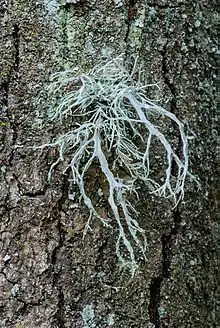Ramalina farinacea
Ramalina farinacea is an epiphytic bushy shaped (fruticose) lichen common to areas with Mediterranean, subtropical, or temperate climates. It is in the Ramalina genus of the family Ramalinaceae.[1] The coexistence of two different species of the Trebouxia genus of green algae at the same time were found to be in each specimen collected in widely distributed populations.[1] The algae thrive in different temperature and light environments. It is thought this demonstrates an ability of the lichen with two simultaneous green algae partners to proliferate in a wider range of habitats and geographic areas.[1]
| Ramalina farinacea | |
|---|---|
 | |
| Ramalina farinacea | |
| Scientific classification | |
| Kingdom: | |
| Division: | |
| Class: | |
| Order: | |
| Family: | |
| Genus: | |
| Species: | R. farinacea |
| Binomial name | |
| Ramalina farinacea | |
| Synonyms | |
| |
This lichen species is characterized by its long, narrow branches (less than 2 to 3 millimeters wide) and clearly defined marginal soralia. It is most often found at low elevations on trees and shrubs.[2]
References
- Two Trebouxia algae with different physiological performances are ever-present in lichen thalli of Ramalina farinacea. Coexistence versus Competition?, Leonardo M. Casano, Eva M. del Campo,Francisco J. García-Breijo, José Reig-Armiñana, Francisco Gasulla, Alicia del Hoyo,Alfredo Guéra1,and Eva Barreno, Environmental Microbiology (2011) 13(3),,
- Goward, Trevor (1999). The Lichens of British Columbia Illustrated Keys Part 2: Fruticose Species. Ministry of Forests Research Program. Retrieved 30 May 2018.